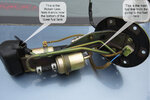Mophead
Site Supporter
After following Uncle Phil's fuel pump dilemma and not wanting to detract from his thread I have always heard to not run the fuel level low because it is hard on the fuel pump.
So the question is does the fuel pump cool itself from fuel surrounding the pump OR does it cool from the fuel being pumped through the pump internally?
We see don't run the fuel level low on this forum, BMW motorcycle forums, Toyota Tundra forums, Chevy truck forums, and just about any motor forum you can imagine.
Before we had fuel pumps inside the tank (auto or MC) I don't remember any cautions on running low fuel level. Since fuel injection and pumps inside the tank we are now told to not use all the gas in the tank. If following that logic we would be filling up every 150 miles instead of doing 220/230 and then filling when closer to empty. More miles if on the ST supertankers.
Granted a fuel pump for carbs versus fuel injection has to work much harder to maintain FI pressures versus carb pressures. PSI versus drip drip drip. Reminds me of replacing small block chevy fuel pumps on the lower right side and using a hacksaw blade to keep the rod up in the block while installing the pump.
I have always run the tank low and not had fuel pump issues (jinx on the way for that statement). If it cooled from the outside wouldn't the fuel pump have cooling fins or something to make more contact with the liquid. As long as fuel is running through the pump, then cooling takes place regardless of how much fuel is in the tank.
This will probably be worse than a tire or oil thread so let 'er rip.
So the question is does the fuel pump cool itself from fuel surrounding the pump OR does it cool from the fuel being pumped through the pump internally?
We see don't run the fuel level low on this forum, BMW motorcycle forums, Toyota Tundra forums, Chevy truck forums, and just about any motor forum you can imagine.
Before we had fuel pumps inside the tank (auto or MC) I don't remember any cautions on running low fuel level. Since fuel injection and pumps inside the tank we are now told to not use all the gas in the tank. If following that logic we would be filling up every 150 miles instead of doing 220/230 and then filling when closer to empty. More miles if on the ST supertankers.
Granted a fuel pump for carbs versus fuel injection has to work much harder to maintain FI pressures versus carb pressures. PSI versus drip drip drip. Reminds me of replacing small block chevy fuel pumps on the lower right side and using a hacksaw blade to keep the rod up in the block while installing the pump.
I have always run the tank low and not had fuel pump issues (jinx on the way for that statement). If it cooled from the outside wouldn't the fuel pump have cooling fins or something to make more contact with the liquid. As long as fuel is running through the pump, then cooling takes place regardless of how much fuel is in the tank.
This will probably be worse than a tire or oil thread so let 'er rip.



